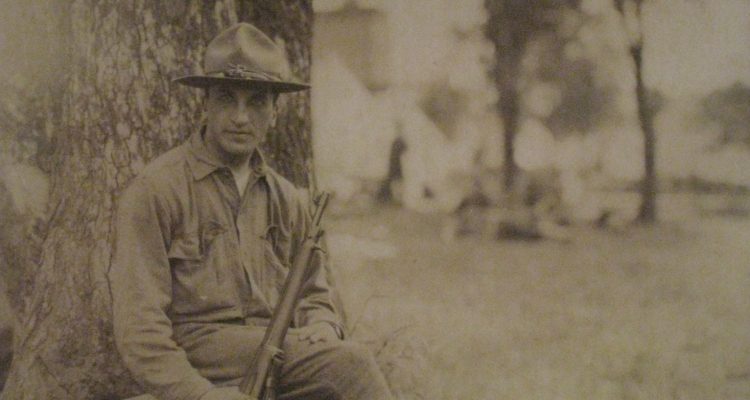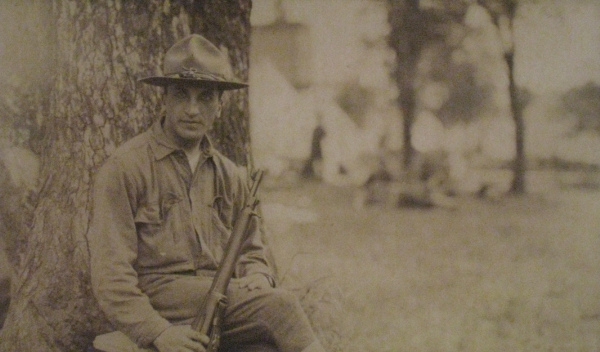
July 14, 1917
This being the important day that we finally leave American territory for France and the big war. I have decided to keep a record of the more important events as they occur.
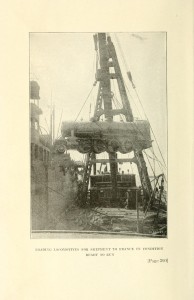
August 10, 1917
In “La Belle France,” and not very much satisfied with what we have seen of it so far, either.
We were assembled at 11 P.M. Aug 6th and headed by a band; marched down to Bordon station. The train pulled out at 12:15 A.M. and at 4:15 A.M. we detrained at Folkestone, on the east coast of England, about 10 miles south of Dover.
We weren’t allowed out of the post, but with several of the other boys we climbed the fence and went out to see the city. Folkestone is the first place in England that we saw some pretty girls and for a change they had some teeth.
We headed across the channel and docked at Boulogne, France at 7:10 P.M. Again we had the beautiful job of lugging our heavy barrack bags half a mile to the railroad station.
August 14, 1917
Moved again. We are now stationed at Maricourt, about twelve miles from Peronne, right on the battlefield of the Somme. This is expected to be the scene of our operations. At present this is at least 40 miles behind the battle line.
Northwestern France, the regions of Nord Pas-de-Calais and Somme, are not wine regions. They are the southern part of Flanders, and their regional drink is beer. Nord Pas-de-Calais produces France’ only indigenous beer, Bier de Garde, and I imagine a bottle of it was a welcome respite after a day of laying rail or building a road with just a pick and shovel.
Castelion Blonde Bier de Garde
WHO Castelaine
WHAT Bier de Garde
WHERE France, Nor Pas-de-Calais
HOW MUCH $12 (750 ml)
The color was yellow and cloudy, and it poured up with a very high fluffy head.
This beer was very full-bodied. The flavor was a little yeasty and nutty, with very fresh hops. The finish had a touch of bitterness and lasted quite a long time.
August 23rd, 1917
I have been taking in the sights of the battlefields. It is really stupendous. For miles and miles the ground is channeled with series of trenches. …
Out in the midst of one field are two graves side by side marked with small wooden crosses. Stenciled in English are, “A German soldier lies here” and the other “Carl Muller, Born 1886, lies here – a German soldier.”
August 26, 1917
We have again moved and are now stationed at Le Chapalette, about 2 miles from Peronne and 12 miles from where we were at Maricourt.
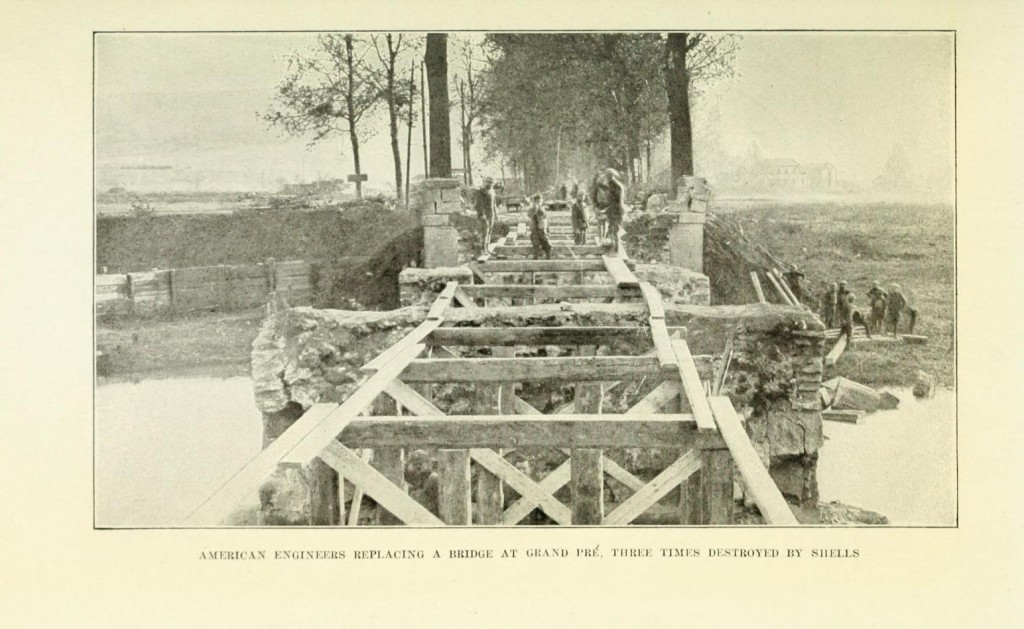
Monday, December 10th, 1918
Company “A” received its baptism of fire today. While a detachment of our boys were working today at Villers-Faucon a German battle plane came over and bombed them and Private Bryn of our company was so badly wounded in the arm that he will lose it above the elbow.
February 5, 1918(Nevers, France)
After several hours of wandering around sightseeing we went on out into the country. Decided to try and get lunch at a farmhouse. We struck a nice likely looking place and found the farmer willing to feed us.
We had our meal right in the farmhouse dining room. Consisting of eggs, red potatoes and all sorts of wines and fruits, the farmer’s wife cooking the meal over the open fire place in a pan with a handle about three foot long. They were so very friendly and it all felt and looked so cozy and familial we hated to leave.
Nevers is near Sancerre, the spiritual home of Sauvignon Blanc. They also produce good red table wines made from pinot noir, so the farmer probably had a terrific selection for these thirsty doughboys.
Let’s face it, a simple country farmer was likely to have, and a doughboy was likely to drink, a simple table wine, something like a Domaine Fouassier, the Vin de Pays du Jardin de la France. I happened to have a $7.98 bottle in my cellar.
2005 Domaine Fouassier Vine de Pays du Jardin
WHO Domaine Fouassier
WHAT Sauvignon Blanc
WHERE France, Loire Valley, Sancerre
WHEN 2005
HOW MUCH $7.98
The color is a very clear bright yellow. Yellow fruit, barely ripe banana and some star fruit and a touch of Zweiback, then grapefruit pith and some grass, make up the palate. It seems a little fat, a bit low in acidity. I am sure it would have been a cool pleasure, a welcome respite from the work of The Great War.
August 30, 1917
A British Tommy showed me a copy of a German document bearing on the means of increasing population which I borrowed and copy herewith. It seems to substantiate many articles that appeared in American papers in the past:
Translation of a German document found on a German prisoner recently captured; dated 20/2/16
“Committee for the increase of the population” (Notice No. 13878)
Sir,
On account of all the able bodied men having been called to the Colours, it remains the duty of all those left behind, for the sake of the Fatherland, to interest themselves in the happiness of the married women and maidens by doubling or even tripling the number of births.
Your name has been given to us as a capable man, and you are herewith requested to take on this office of honour and to do your duty in right German style. It must be pointed out that your wife or fiance will not be able to claim a divorce; it is in fact to be hoped that the women will bear this discomfort heroically for the sake of the war.
You will be given the district of ___. Should you not feel capable of coping with the situation, you will be given three days in which to name someone in your place.
On the other hand, if you are prepared to take on a second district as well, you will become a “Dochoffiqui” (sp? might be incorrect, trying to read my grandfather’s handwriting) and receive pension.
An exhibition of women and maidens as well as a collection of photographs is to be found at our office. You are requested to bring this letter with you.
Your good work should commence immediately and it is in your interests to submit to us a full report of results after 9 months.
W.L.O. Teviss, Major
General Staff
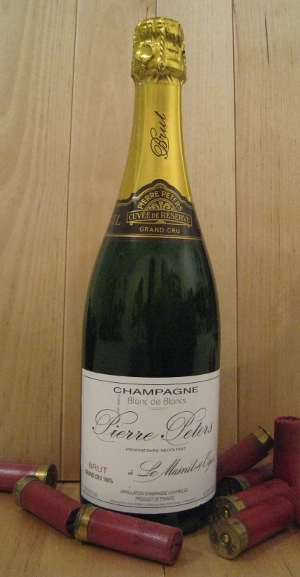
The closest AOC to Paris is Champagne. I have no idea whether Grandpa had any while he was there, but if he did, I hope he had something as delightful as this blanc de blancs grower champagne.
N.V. Pierre Peters Champagne Blanc de Blancs Brut Cuvée de Réserve
WHO Pierre Peters
WHAT chardonnay
WHERE France, Champagne, Le Mesnil Sur Oger
WHEN non-vintage
HOW MUCH $43
The color is clear light golden straw, and bubbles are tiny tiny tiny. The nose is rich and yeasty, fresh-baked bread and buttered toast, with light delicate citrus (key limes and a hint of pink grapefruit) and lychee.
The palate is equally delightful. The mousse is full but delicate, mouth-filling yet light as air at the same time. The fruit on the palate is like the fruit on the nose- key lime and a touch of sweet grapefruit. Florals were equally citrusy, orange blossoms from a distance. The toast evolved from attack to midpalate in a fascinating way. Up front it was yeasty and toasty, but as that flavor blended with the fruit, well, the best way to describe it is an incredibly light key lime pie with a Zweiback crust. The overall sense of this wine is sweetness, but it is not sweet. It also had clear minerality, but only as background, not foreground.
The finish lasted quite a while, the different tastes all coming together and lingering, all very light but lasting.
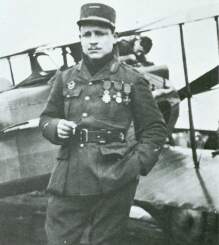
September 9, 1917 (Paris)
Here we had the honor of meeting Raoul Lufberry, the famous American aviator of the Lafayette Escadrille, attached to the French army. He has many times been decorated by the French government. He told us he had formerly been in the 20th infantry, U.S. Army.
October 18, 1917
The Government has arranged that the men can buy [Liberty Bonds] on the installment plan. An allotment of $5 a month for ten months is made in favor of the government for each $50 bond. The men have taken hold of this plan to show the world the army is behind the war with a vim and have bought between $115,00 and $120,000 worth of bonds in this regiment alone. That is the enlisted men only and does not include the officers. I have not the exact figures and so cannot give the exact amount. Personally I took two bonds.
October 22, 1917
Yesterday was a red-letter day for me — I visited the first line trenches of the British troops.
…
We were on the right road at last. We passed a British sentry who told us to travel in single file and keep as inconspicuous as possible as the road was under the observation of the German balloon we could see in the air.
…
The sergeant in charge here was very pleasant and I had a look through the big telescope in the observation dug-out. Fifteen hundred yards away on the brow of the hill facing us, with a valley between I could plainly see the German trenches. As I looked a German soldier came walking down the road behind the trench with two big cans in his hands. Through the telescope I could see him quite plainly. I can’t describe the sensation I felt on seeing our enemies in their lines so plainly. All of us wanted to take a shot at them but the Tommies said things were being kept very quiet in that part of the line.
On the road out of the trenches we narrowly escaped some shrapnel shells which burst over us. They may have been directed at us as we were very much excited over what we had seen and had grown careless.
December 1, 1917
Our regiment has received its baptism of fire. The Germans broke through the new lines captured this week by the British. Our men of B & F Co’s were working immediately behind the line at Gougeaucourt and were caught in the rapid dash made by the Huns. They were ordered to scatter but many fought back the Bosche with fists, picks and shovels in lieu of the rifles they had left behind in camp. We do not know yet exactly what the casualties are but it is pretty certain that at least nine have been killed.
This newspaper clipping was taped into the diary:
The Daily Mail, December 3, 1917
AMERICAN PIONEERS JOIN IN
The fine courage of a number of American soldiers was notable, too, in this great test. They were not regular soldiers but pioneers and expert railway workers, who for some time past have been lending their strength and their quick intelligence in the work of construction and repair that goes on behind the front line. They carried no arms, but when the attack came they were in no mood to be out of it. They threw away their picks and shovels, and with the rifles and cartridges of the dead and wounded they leapt into the line. Some fell gloriously with their faces to the enemy. All of them took part, and there is no one who saw their work but renders homage to the coolness and the discipline with which these self-improvised fighting men took their baptism of fire.
The world does not stop at home when men and women go off to war. This particular passage, a man dealing with the loss of his father in just a sentence or two, but what poignant sentences, struck me hardest of the entire diary.
December 13, 1917
In reply to my cable I received word last night from my brother Harry that Papa had died last August. It is hard for me to realize what has happened – my sensibilities seem to be dulled by my separation from home. It is an awful shock to me but I am doing my best to keep my mind off it. Papa dear — I don’t know how I can ever become reconciled to the fact.
February 18, 1918
Yesterday I passed a most enjoyable day wandering around the streets of Nevers, the city near which we are camped.
Never have I seen a city so quaint and interesting, so original and typically French, combining in itself all the pictures I had drawn in my mind or had seen of those odd bits of European cities; – in the public marketplace, the narrow twisting streets and black, dark, meandering canals with the evil, forbidding looking backs of the little houses overhanging its banks.
April 11, 1918(Savy)
Never have I been so disgusted with the army as I am tonight. For two cents I’d quit.
Our morning schedule is such now we hardly have time to eat before fatigue call. Then after rushing this morning we hiked about 3 miles to our job. That was all on a breakfast of half a spoonful of hash, half a cup of coffee and [crackers]. We worked hard all morning until 12:30 and then had our meal on the job, though we hadn’t been told to bring any mess kits along. The “meal” consisted of one cup of coffee, a little [cracker] and a small slice of bully-beef. On those strengthening meals we worked until 5.30 P.M. and then hiked back to camp.
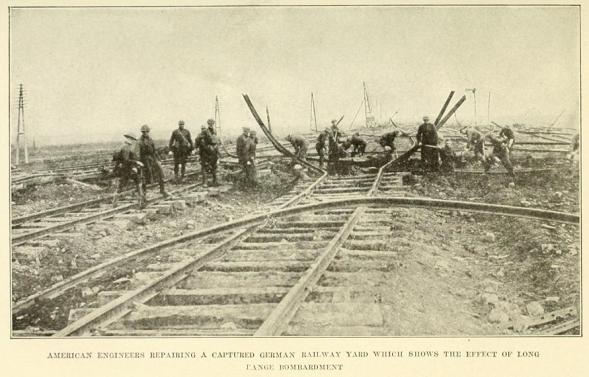
April 14, 1918
These last few days have sure been ones of excitement for us.
Friday morning at about 11. A.M. while we were digging away at the trenches, a large shell suddenly exploded about 100 yards in front of the section of trenches our company was working on. Two of our men and one man from Co. “C” were wounded. The men ducked below the breastworks and Cap. Green of Co. “C” came along ordering everyone to get up and work, that the shelling was all over. About seven minutes after the first shell exploded another went off. This did awful execution. Herman Selares of the old [?] section gang was killed outright and a recruit by the name of Brown. Sgt. Bill Bell and Wells were seriously hurt and about 19 others were seriously and slightly wounded.
There certainly should have been no casualties but the three wounded by the first shell. It was a very bright day, we were working within range and were in plain view of the enemy observation balloons and enemy planes were sailing over-head giving the range. It stood to reason that more shells were going to come. Only stupidity or indifference caused the men to be ordered back to work after the first shell exploded and the deaths of these men can only be laid at the door of the officer who ordered the men back to work.
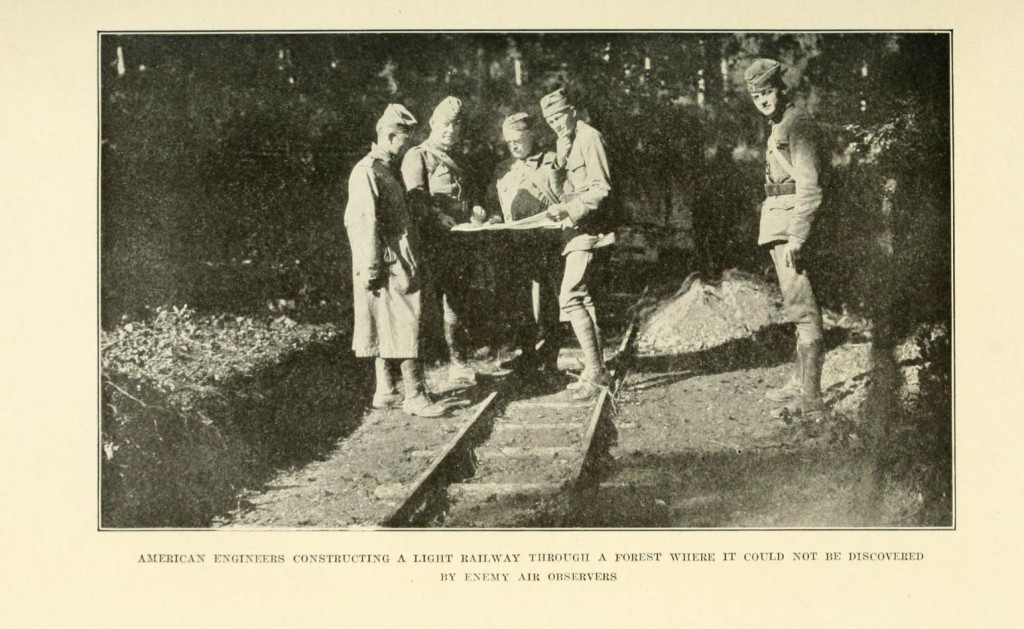
May 25, 1918(Hesdigneul)
Today I was raised to the dignity of a 1st Class Private. After a years service in the army that is wonderfully rapid advancement. But ambition, as far as the army is concerned, is not my strong forte.
June 22, 1918(Montierchaume, near Chateauroux)
This has been a great week- one whole week of solid rest. We have practically done nothing at all – worked a couple of hours a day on the roads to get up an appetite. It’s what we wanted and I think we are feeling the better for it.
Also the whole regiment is quarantined because of an epidemic of influenza. It’s nothing serious- just a light touch of grippe.
(This was almost certainly the Spanish Flu, a pandemic that killed 3-6% of the world’s population, anywhere from 20 million to 100 million, depending upon the estimate (and more modern estimates are actually higher, 50-100M). It is also consistent with records, for the Spanish Flu was mild the first time around, then did its damage in mutated form beginning in the Fall, 1918. My Grandfather was perhaps fortunate in catching it in the Summer, for the next time it visited his Company it killed many of his comrades. see below.)
Lyon is north of Cote-Rotie, the northernmost region of the Rhone Valley, and south of Beaujolais, the southernmost region of Burgundy. Beaujolias, made from the gamay grape, can be a bright, fruity light weight. But it can also be a deep wine more than worthy of the sobriquet “Burgundy.” Wine from Cote-Rotie, the “roasted slope,” named for its long exposure to the sun, is made of syrah and up to twenty percent viognier, which must be co-fermented.
2000 E. Guigal Côte-Rôtie Brune et Blonde
WHO E. Guigal
WHAT Syrah
WHERE France, Northern Rhone, Côte-Rôtie
WHEN 2000
HOW MUCH $50
The nose is very smoky, with smoldering hickory, bacon, black olives and black cherries. The palate has less smoke, but the same black olives, black cherries, and some bacon fat, along with pepper. The finish falls off a little quickly. This is a wine that begs for food to really show its stuff, though I doubt tins of British bully beef did it justice.
July 30, 1918 (Lyon)
The ride all day was wonderful. The scenery nicer than any I had ever seen before. For some time before coming to Lyon the train runs alongside the Rhone river, broad and flat lands, the meadows running right down to the river, the mountains beginning to rise about a mile from the river. At Lyon we found we couldn’t get a trail to Aix-les-Bains until the next morning so we went into the city to look around.
2007 Domaine C. Ducroux Regnie
Minerals and strawberries, plus a single spray of oil from a key lime rind, blend together beautifully on the nose. The palate opens with a quick startling flavor of beef fat and dark berries, leading to strawberries and plums, along with strong minerality lasting through the finish. This has a velvety richness that would shock so many who think “Beaujolais” is synonymous with “Beaujolais Neuveau.” It would be delicious with pork, duck, or even a rich chicken dish.
WHO: Domaine C. Ducroux
WHAT: Gamay
WHERE: France, Beaujolais, Regnie
WHEN: 2007
PRICE: $14.99
July 31, 1918(Aix-les-Bains)
Lots of news this time – all about my leave. I got it at last. With the other boys going I left camp for Paris en route to Aix-les-Bains.
The arrangements at Aix were all that could be desired. Everything to make us comfortable and enjoy their weeks stay there has been thought of. The beautiful casino has been taken over by the YMCA and all sorts of entertainments and amusements were provided.
During the week I took in the various sights of the district – the trip up Mount Revard on the cog-wheel railroad, steamboat trip around the lake and to Hautecombe Abbey and a visit to the Gorges du Sierroz.
2007 Domaine Labbé Vin de Savoie Abymes
WHO Domaine Labbé
WHAT Jacquère
WHERE France, Savoie
WHEN 2007
HOW MUCH $14
A simple, acid-driven white, it opened with lemon -lime and a crisp streak of acid. As it got warmer pineapple became predominant. This is a simple, inexpensive, regional wine, of interest primarily as a unusual curiosity. For the men on leave, though, getting their only free week in two years of war and occupation, I have no doubt it was ambrosia.
September 13, 1918(Sorcy, near Commercy)
The American drive against the St. Michel sector, which is right ahead of us has been a wonderful success and thousands of prisoners have been taken. I spoke to quite a few of the prisoners that were brought in at Commercy and they seem to be pretty well tired of the war.
Many of them looked only 16 years old though they all claimed they were 19.
November 13, 1918(Bennecourt)
So at last it is all over. I can hardly realize it – especially so as we are going right on, working on the yard here at Bennecourt. We made a little local celebration of our own here. Monday night and last night and used up beaucoup cordite, flares, rockets and ammunition.
Its going to be a long, dreary wait now for us, until the peace terms are signed and until we start that trip home.
November 23, 1918(Metz)
I had a great trip to the city of Metz yesterday and some adventures getting there.
We got as far as the town of Neudorf when we were stopped by American colored guards. No one was allowed through without a pass. We went back, crossed a brook after taking our shoes and stockings off and crossing the Moselle River, passed the guards and got in the railroad yard. There we got an engine going to Metz.
I spoke to many people and it seems to be France is going to have quite a problem there. It won’t be all easy for her. There are as many who prefer the former German rule to the French.
One opinion is that Alsace-Lorraine should be a separate country.
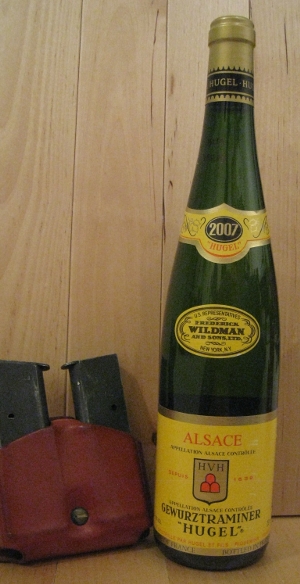
2006 Hugel et Fils Gewürztraminer “Hugel”
WHO Hugel et Fils
WHAT Gewürztraminer
WHERE Alsace
WHEN 2006
HOW MUCH $22
The nose was still sweet and fruity. Lychee was the primary smell, joined with some ripe peach. It was not overpoweringly sweet, balanced by a clean mineral smell plus just a bit of lime zest.
This was a very good wine. I recommend it highly.
February 7, 1919(St. Andre de Cubzac)
This camp has turned out to be a very poor one for the 11th Engineers. We have a very large sick list, – influenza, bronchitis and pneumonia. Though we lost only five men through sickness in 1 1/2 year’s of campaigning we have lost already three men in the two weeks here and many more are dangerously ill in the hospital. Ed. Fitzgerald of our company, one of the old men, died.
Even if he was in Bordeaux, an enlisted man was not going to easily lay his hands upon any First Growths. Instead, he was more likely to find something like this wine.
WHO: Chateau Moulin de Curat
WHAT: Merlot (60%) Cabernet Franc (35%) and Cabernet Sauvignon (5%)
WHEN: 2005
WHERE: France, Bordeaux, Libournais
HOW MUCH: $23.98
The year 2005 is considered by most the best year in decades, one in which the great wines are perfect, the good wines are great, and the average wines are good. If this very moderately priced bottle is any indication, they are right.
This is a terrific early drinker from a vintage with so many wines worthy of long-term cellaring. There is very little evidence of wood, as the wine maker obviously decided to let the grapes speak for themselves. Blackberries and blackcurrants have a background of tobacco, all wrapped gently in leather from smooth tannins. The finish was long, the flavor lingering for half a minute or more.
February 10, 1919 (Bordeaux)
The city gives a very pleasant impression with its many monuments and squares and the business district teemed with activity.
This morning I acted as one of the pall-bearers at the funeral of Frank Lenninger who died Friday the 7th. He belonged to my squad and we were also together at Fort Dutton. Another of the old long-gone on the cusp of going home.
April 24, 1919 (at sea)
On board the S/S Chicago, on the broad Atlantic. Yes, at last.
Date unknown
Now that I have arrived in America I will close this diary of mine glad to have been through it all and mighty glad to come back safe and sound.
On November 11, 1918, the greatest war the world had yet seen came to an end. It was fought by young men, an entire generation lost when 19th century tactics met 20th century technology. Stories of heroism and gallantry, which there certainly were in abundance, fail to capture the day to day reality of men away from home, losing parents from thousands of miles away, friends dying, and doing their job, minute by minute, until somebody finally said “enough.”
Veterans Day, originally Armistice Day, commemorates the armistice, the day the shooting stopped, rather than the victory, the day a treaty was signed. That is how it should be, for millions of men like Archie Brick, PFC, Company “A,” 11th Engineers, just wanted it to stop, so they could go home to their families.
Thank you Grandpa, and thank you to the millions of men who have fought for freedom and for justice .
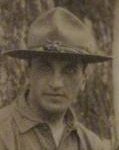
by Archie Brick, PFC, Company “A,” 11th Engineers, United States Expeditionary Forces, with the assistance of his loving grandson, David Honig.


